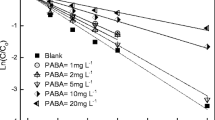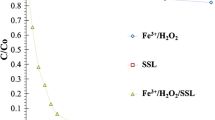Abstract
Direct photolysis of the emerging contaminant 2-(thiocyanomethylthio) benzothiazole (TMCTB) was performed in aqueous solution at different concentrations with high-pressure mercury lamp (5.0, 8.0, 13.0, 16.0, 20.0, 23.0, 27.0, 35.0, 40.0, 45.0, and 50.0 mg L− 1) and with natural sunlight radiation (6.0, 30.0, and 60.0 mg L− 1). TCMTB underwent rapid degradation by direct photolysis with a high-pressure mercury lamp in aqueous solutions, with 99% removal after 30 min at all concentrations studied. For sunlight photolysis, TCMTB degradation was observed with 96%, 81%, and 64% removal for initial concentrations of 6.0, 30.0, and 60.0 mg L− 1, respectively, after 7 h of exposure to sunlight. The degradation of TCMTB in lab-scale wastewater had kinetic constant and t1/2 in the same order when compared to the photodegradation of TCMTB in aqueous solutions. In addition, the results showed that photolysis with a high-pressure mercury lamp and sunlight were governed by the same kinetic order, however the kinetic parameters showed that degradation with sunlight was 40 times slower than photolysis with the mercury lamp. Twelve transformation products (TP) were identified, and eight of the TP have not been described in the literature. Furthermore, prediction of toxicity with ECOSAR software was carried out for fish, daphnids, and green algae species. It showed that photolytic treatment is efficient for reducing the toxicity of the compound, since the degradation formed compounds with lower toxicity than the primary compound. In conclusion, this study suggests that photolysis is an efficient way to remove the studied contaminant, and it highlights the potential of this technique for the degradation of emerging contaminants in industrial wastewater treatment plants.




Similar content being viewed by others

References
Alharbi SK, Kang J, Nghiem LD et al (2017) Photolysis and UV/H2O2 of diclofenac, sulfamethoxazole, carbamazepine, and trimethoprim: Identification of their major degradation products by ESI–LC–MS and assessment of the toxicity of reaction mixtures. Process Saf Environ Prot 112:222–234. https://doi.org/10.1016/j.psep.2017.07.015
Andreozzi R, Caprio V, Marotta R (2001) Oxidation of benzothiazole, 2-mercaptobenzothiazole and 2-hydroxybenzothiazole in aqueous solution by means of H2O2/UV or photoassisted Fenton systems. J Chem Technol Biotechnol 76:196–202. https://doi.org/10.1002/jctb.360
Bahnmüller S, Loi CH, Linge KL et al (2015) Degradation rates of benzotriazoles and benzothiazoles under UV-C irradiation and the advanced oxidation process UV/H2O2. Water Res 74:143–154. https://doi.org/10.1016/j.watres.2014.12.039
Benitez FJ, Acero JL, Real FJ et al (2013) Photolysis of model emerging contaminants in ultra-pure water: Kinetics, by-products formation and degradation pathways. Water Res 47:870–880. https://doi.org/10.1016/j.watres.2012.11.016
Borowska E, Felis E, Kalka J (2016) Oxidation of benzotriazole and benzothiazole in photochemical processes: Kinetics and formation of transformation products. Chem Eng J 304:852–863. https://doi.org/10.1016/j.cej.2016.06.123
Brienza M, Mahdi Ahmed M, Escande A et al (2016) Use of solar advanced oxidation processes for wastewater treatment: Follow-up on degradation products, acute toxicity, genotoxicity and estrogenicity. Chemosphere 148:473–480. https://doi.org/10.1016/j.chemosphere.2016.01.070
Brownlee BG, Carey JH, MacInnis GA, Pellizzari IT (1992) Aquatic environmental chemistry of 2-(thiocyanomethylthio)benzothiazole and related benzothiazoles. Environ Toxicol Chem 11:1153–1168. https://doi.org/10.1002/etc.5620110812
Carlson JC, Stefan MI, Parnis JM, Metcalfe CD (2015) Direct UV photolysis of selected pharmaceuticals, personal care products and endocrine disruptors in aqueous solution. Water Res 84:350–361. https://doi.org/10.1016/j.watres.2015.04.013
Céspedes R, Lacorte S, Ginebreda A, Barceló D (2006) Chemical monitoring and occurrence of alkylphenols, alkylphenol ethoxylates, alcohol ethoxylates, phthalates and benzothiazoles in sewage treatment plants and receiving waters along the ter River basin (Catalonia, N. E. Spain). Anal Bioanal Chem 385:992–1000. https://doi.org/10.1007/s00216-006-0448-8
Chen P, Wang F, Zhang Q et al (2017) Photocatalytic degradation of clofibric acid by g-C3N4/P25 composites under simulated sunlight irradiation: The significant effects of reactive species. Chemosphere 172:193–200. https://doi.org/10.1016/j.chemosphere.2017.01.015
Corrêa MDP (2015) Solar ultraviolet radiation: Properties, characteristics and amounts observed in Brazil and south America. An Bras Dermatol 90:297–313. https://doi.org/10.1590/abd1806-4841.20154089
Dimpe KM, Nomngongo PN (2016) Current sample preparation methodologies for analysis of emerging pollutants in different environmental matrices. TrAC Trends Anal Chem 82:199–207. https://doi.org/10.1016/j.trac.2016.05.023
Diogène J, Bekaert K, Cunha S et al (2015) Environmental contaminants of emerging concern in seafood – European database on contaminant levels. Environ Res 143:29–45. https://doi.org/10.1016/j.envres.2015.06.011
Estrada-Arriaga EB, Cortés-Muñoz JE, González-Herrera A et al (2016) Assessment of full-scale biological nutrient removal systems upgraded with physico-chemical processes for the removal of emerging pollutants present in wastewaters from Mexico. Sci Total Environ 571:1172–1182. https://doi.org/10.1016/j.scitotenv.2016.07.118
Felis E, Sochacki A, Magiera S (2016) Degradation of benzotriazole and benzothiazole in treatment wetlands and by artificial sunlight. Water Res 104:441–448. https://doi.org/10.1016/j.watres.2016.08.037
Filipe OMS, Santos SAO, Domingues MRM et al (2013) Photodegradation of the fungicide thiram in aqueous solutions. Kinetic studies and identification of the photodegradation products by HPLC-MS/MS. Chemosphere 91:993–1001. https://doi.org/10.1016/j.chemosphere.2013.01.092
Fontoura JT, Ody D, Gutterres M, Alegre P (2016) Performance of Antimicrobial Agents for the Preservation of Chrome Leather. J Am Leather Chem Assoc 111:221–229
Fries E, Gocht T, Org Klasmeier J (2011) Occurrence and distribution of benzothiazole in the Schwarzbach watershed (Germany). J Environ Monit 13:2838–2843. https://doi.org/10.1039/c1em10474h
Ge L, Na G, Chen CE et al (2016) Aqueous photochemical degradation of hydroxylated PAHs: Kinetics, pathways, and multivariate effects of main water constituents. Sci Total Environ 547:166–172. https://doi.org/10.1016/j.scitotenv.2015.12.143
Krupa J, Wierzejewska M (2015) UV-tunable laser induced photolysis of matrix isolated anisole. Chem Phys Lett 618:219–224. https://doi.org/10.1016/j.cplett.2014.11.020
Li H, Duan L, Wang H et al (2020) Photolysis of sulfadiazine under UV radiation: Effects of the initial sulfadiazine concentration, pH, NO3 – and Cd2+. Chem Phys Lett 739:136949. https://doi.org/10.1016/j.cplett.2019.136949
Lutterbeck CA, Wilde ML, Baginska E et al (2016) Degradation of cyclophosphamide and 5-fluorouracil by UV and simulated sunlight treatments: Assessment of the enhancement of the biodegradability and toxicity. Environ Pollut 208:467–476. https://doi.org/10.1016/j.envpol.2015.10.016
Márquez Brazón E, Piccirillo C, Moreira IS, Castro PML (2016) Photodegradation of pharmaceutical persistent pollutants using hydroxyapatite-based materials. J Environ Manage 182:486–495. https://doi.org/10.1016/j.jenvman.2016.08.005
Miksch K, Cema G, Corvini PFX et al (2015) R&D priorities in the field of sustainable remediation and purification of agro-industrial and municipal wastewater. N Biotechnol 32:128–132. https://doi.org/10.1016/j.nbt.2013.11.002
NASA (2019) NASA data access viewer. https://power.larc.nasa.gov/data-access-viewer/
Nawrocki ST, Drake KD, Watson CF et al (2005) Comparative aquatic toxicity evaluation of 2-(thiocyanomethylthio)benzothiazole and selected degradation products using Ceriodaphnia dubia. Arch Environ Contam Toxicol 48:344–350. https://doi.org/10.1007/s00244-004-0105-1
Parsons S (2004) Advanced oxidation processes for water and wastewater treatment. IWA
Pereira EB, Martins FR, Gonçalves AR et al (2017) Brazilian Atlas for Solar Energy
Razanajatovo RM, Ding J, Zhang S et al (2018) Sorption and desorption of selected pharmaceuticals by polyethylene microplastics. Mar Pollut Bull 136:516–523. https://doi.org/10.1016/j.marpolbul.2018.09.048
Remucal CK (2014) The role of indirect photochemical degradation in the environmental fate of pesticides: a review. Environ Sci Process Impacts 16:628–653. https://doi.org/10.1039/c3em00549f
Rogowska J, Cieszynska-Semenowicz M, Ratajczyk W, Wolska L (2020) Micropollutants in treated wastewater. Ambio 49(2):487–503. https://doi.org/10.1007/s13280-019-01219-5
Wang Y, Roddick FA, Fan L (2017) Direct and indirect photolysis of seven micropollutants in secondary effluent from a wastewater lagoon. Chemosphere 185:297–308. https://doi.org/10.1016/j.chemosphere.2017.06.122
Wilkinson J, Hooda PS, Barker J et al (2017) Occurrence, fate and transformation of emerging contaminants in water: An overarching review of the field. Environ Pollut 231:954–970. https://doi.org/10.1016/j.envpol.2017.08.032
Zhang Y, Xiao Y, Zhang J et al (2017) Degradation of cyclophosphamide and 5-fluorouracil in water using UV and UV/H 2 O 2: Kinetics investigation, pathways and energetic analysis. J Environ Chem Eng 5:1133–1139. https://doi.org/10.1016/j.jece.2017.01.013
Acknowledgements
The author would like to thank the Coordination for the Improvement of Higher Education Personnel (CAPES), Financing Code 001; Funding Authority for Studies and Projects (FINEP, MCTI/FINEP CT-HIDRO 01/2013) and National Institute for Advanced Analytical Science and Technology (INCTAA, CNPq proc. 465768/2014-8) for financial support.
Author information
Authors and Affiliations
Corresponding authors
Additional information
Publisher's Note
Springer Nature remains neutral with regard to jurisdictional claims in published maps and institutional affiliations.
Electronic supplementary material
Below is the link to the electronic supplementary material.
Rights and permissions
About this article
Cite this article
Bertoldi, C., de Cássia Campos Pena, A., Dallegrave, A. et al. Photodegradation of Emerging Contaminant 2-(tiocyanomethylthio) Benzothiazole (TCMTB) in Aqueous Solution: Kinetics and Transformation Products. Bull Environ Contam Toxicol 105, 433–439 (2020). https://doi.org/10.1007/s00128-020-02954-2
Received:
Accepted:
Published:
Issue Date:
DOI: https://doi.org/10.1007/s00128-020-02954-2



